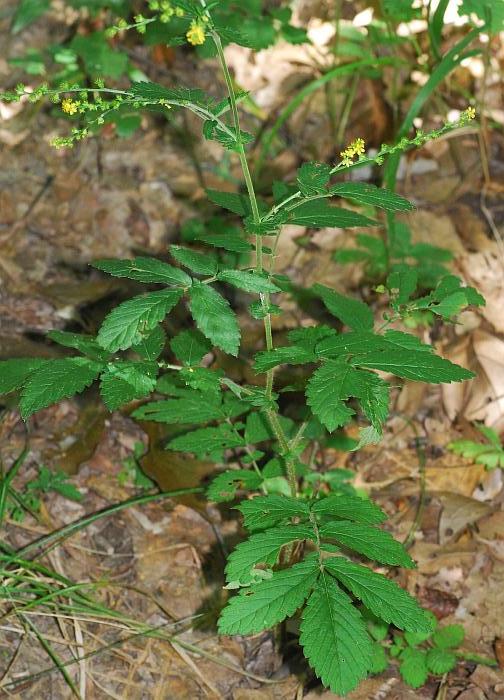Agrimonia pubescens Wallr.
Downy Agrimony

Native
CC = 4
CW = 5
MOC = 78
© DETenaglia
Agrimonia pubescens Wallr.Downy Agrimony | |
 |
Native CC = 4 CW = 5 MOC = 78 |
© DETenaglia |
|
Family - Rosaceae Habit - Perennial forb with both fibrous and tuberous-thickened roots. Stems - Ascending to erect, to 1.0 m, simple to branching above, moderately to densely pubescent with short, ascending to incurved, and long, spreading to reflexed hairs.
Leaves - Alternate, pinnately compound, stipulate, 1.5-30.0 cm long. Primary leaflets 3-9, 1-10 cm long, mostly lanceolate to elliptic or narrowly obovate, narrowed or tapered to a bluntly or sharply pointed tip, the margins with mostly relatively blunt teeth, the upper surface glabrous or pubescent with sparse to moderate, short, appressed hairs along the midrib and sometimes also sparse, long, spreading hairs, the undersurface not glandular, but densely velvety-pubescent with hairs of various lengths and orientations.
Inflorescences - Terminal spikelike racemes, the flower stalks very short, each subtended by a small deeply 3-lobed bract (the hypanthium also subtended by a pair of inconspicuous 3-lobed bractlets). Inflorescence axis not glandular, but densely pubescent with short ascending hairs and usually also sparse, long, spreading hairs.
Flowers - Petals 5, yellow, 2.5-3 mm long, 2 mm broad, elliptic. Stamens mostly 10. Filaments glabrous, pale yellow to white, 1.2 mm long. Anthers orange, 0.6 mm broad. Styles (and pistils) 2, protruding from center of nectar ring, glabrous, 0.9 mm long. Ovary concealed within hypanthium. Hypanthium turbinate, pubescent, 10-nerved, 1.1mm long (in flower), with ring of uncinate bristles subtending corolla. Bristles to 1mm long. Sepals 5, spreading, acute, 1.5mm long, 1.1mm broad, glabrous or with a few hairs at apex.
Fruits - Hypanthium at fruiting 2.5-5.0 mm long (5-7 mm long, including the beak), deeply grooved, not glandular, but minutely hairy in the grooves, usually with sparse longer hairs along the ridges.
Flowering - July - September. Habitat - Forests, savannas, glades, upland prairies, streambanks, tops of bluffs, fields. Origin - Native to the U.S. Lookalikes - A. rostellata. Other info. - This is one of the more common of the four species of Agrimonia that occur in Missouri. It occurs across the state, and also across most of the eastern half of the continental U.S., particularly in the upper Midwest. It is recognized by its compound leaves with toothed leaflets and willowy, wandlike inflorescences of small yellow flowers. A close look at the leaflet undersides or the inflorescence axis will show dense hairiness. This character differentiates the plant from A. rostellata, which is less hairy and also has visible glandularity in these areas. While fruiting, either plant is likely to be overlooked in the field. The fruits, however, attach to clothing (or fur or hairy legs) and will certainly be noticed when you get home. They are a bit of a pain to pull from your apparel. The small flowers are actually quite easy to notice as they add a splash of light to the dark forest floor. Photographs taken at the Sunklands Conservation Area, Shannon County, MO., 7-29-04 (DETenaglia); also at Canaan Conservation Area, Gasconade County, MO, 8-13-2013, Victoria Glade, Jefferson County, MO, 8-25-2015, and at Glassberg Conservation Area, Jefferson County, MO, 8-5-2020 (SRTurner). |